https://www.youtube.com/watch?v=ZzLPUoetSHw
How To Make Every Sushi _ Method Mastery _ Epicurious

I'm Taka Saka , executive chef and co owner of NAMI Nori in New York City .
I'm here to show you how to make every variety of sushi .
All featuring salmon .
Traditionally , salmon was not used in sushi .
It used to carry a lot of parasites .
But thanks to modern refrigeration and aquaculture has become a staple in many Japanese restaurants .
The word sushi translates to it is sour and this is referring to the vinegar rice .
It does not need to be in a roll , it does not even need to have any raw fish .
And with that , let's start by making the rice rice being the most important component to sushi .
I really do suggest to invest in a rice cooker .
This dry rice is a Japanese short grain rice called Koshi .
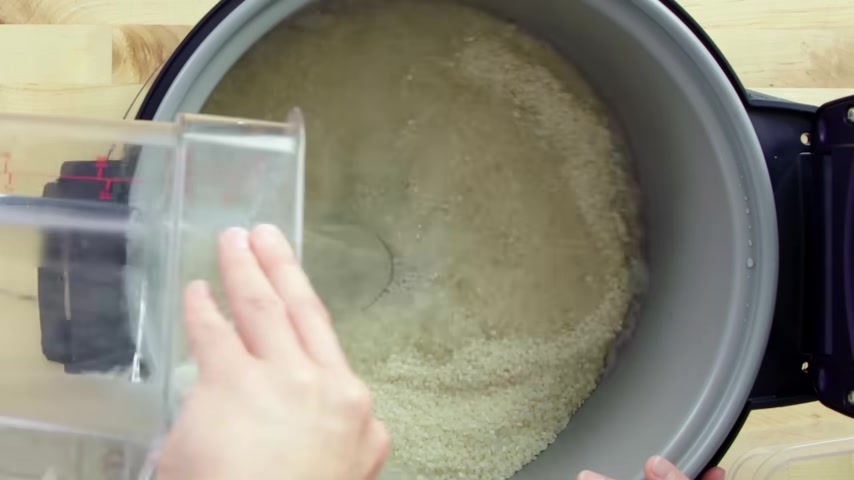
So the first step to making perfect rice is to make sure the rice is washed properly .
We rinse this several times and make sure that the water is running clear before we move on to the next step .
So the ratios we have here today , one part rice to 1.1 part water .
So now we just turn the rice cooker on .
This should take about 40 minutes .
We'll be putting the rice into the Hugi .
This is a traditional rice mixing pot .
This is made out of cyrus .
If you don't have these , you can just reuse a regular bowl and a spatula .
Here we have sushi vinegar , which is rice vinegar mixed with salt and sugar .
If you want to pour this as evenly as possible over the rice and as gravity pulls the vinegar to the bottom , we're just going to flip this rice and simultaneously remove any of the large clumps .
And then from here , I'm just going to make small piles and cut .
We call is to cut the rice to make sure each and every grain is making contact with the vinegar .
Basically means to grab .
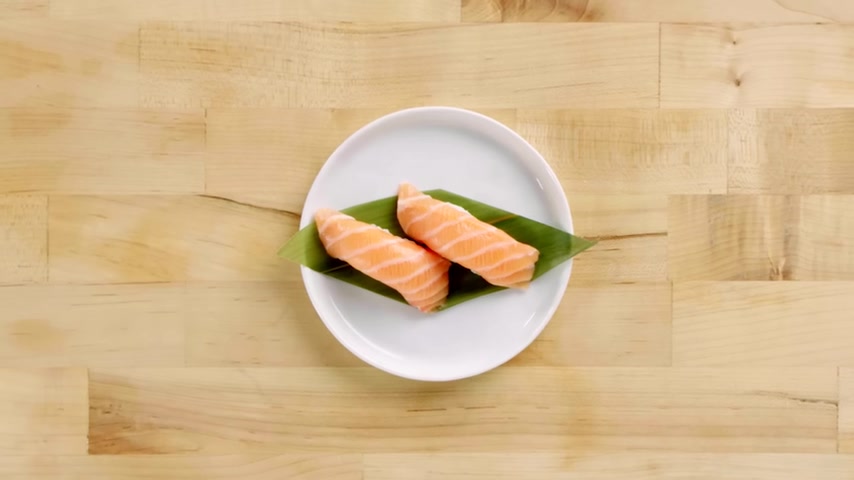
And Nigiri sushi is translated to hand pressed .
Sushi .
Nigiri sushi is when a round , oval shaped mound of rice and a slice of fish come together as one in front of me , I have here a piece of sushi grade salmon .
If you do purchase this at your local market , please make sure that it is sushi grade to avoid any food borne illness .
So the first thing that we want to do here is to take the salmon and create a saku saku first to the rectangular piece of fish that we will then use to slice for sushi .
I like to cut my saku to about four centimeters .
The other piece here that is not a nice , beautiful saku .
We will use this other piece for other applications like rules .
In order to create a very tender piece of fish , we want to always be cutting against the grain of the S S is connective tissue that's connecting the muscle fibers together .
And so we can see here sine is running this way and in order to cut against it , we will be cutting this way .
My knife is here .
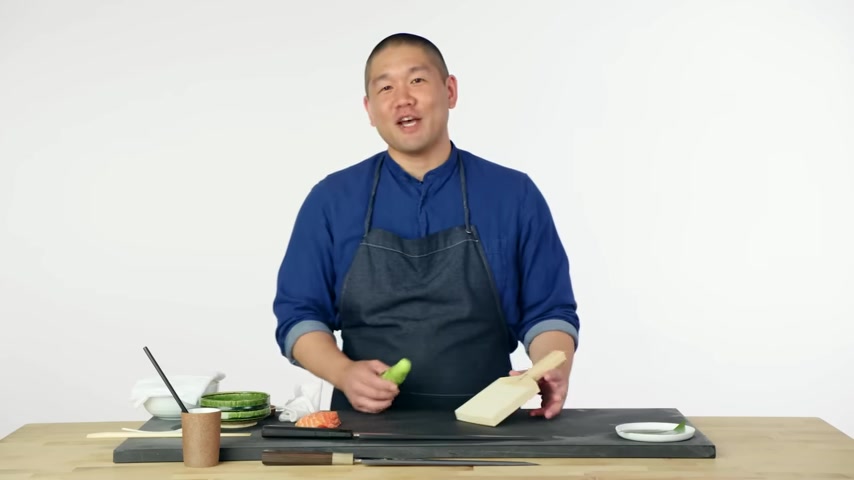
It's cutting against this sine line , but it's also cutting against this sine line as well .
You want to make sure that your knife is long enough so that we can cut it in one stroke versus sawing through the fish .
So the first cut here , again , these pieces will be using for something else .
The cutting technique is called soI zui .
And it's very important here that we turn the edge here by turning the edge , we actually create a very clean cut on the edge .
But also we call jane , which is the roof , which creates a little edge here so that it can catch the soy sauce .
There's usually a touch of wasabi between the fish and the rice .
So today I have a piece of fresh wasabi and all I'm going to do is grate this a lot of the wasabi that you'll find in markets will be horseradish with food color .
This is the real deal real wasabi has natural sweetness already in there and the spiciness tends to be a little bit more mild versus your horseradish counterparts .
What we have here is a bowl of Teu .
Teu is water mixed with a little bit of rice vinegar .

This is here to moisten our hands so that the rice doesn't stick , but also the vinegar is there so that we don't dilute the flavor of the rice too much .
And I'm going to be grabbing the nta the fish here and making sure that where we created the is on the back side and just place it right here in the center of my four fingers .
There's a few techniques to molding the sushi .
The first one I'll be showing is te .
So right now with the rice , I'm just trying to grab the right amount of rice .
This piece right now that I have is probably around eight g or so .
And then just taking a dab of wasabi , putting it right in the center .
Essentially , I'm trying to create a rectangle with this rice .
And so first step here is to create an L here .
And so the thumb and then these three fingers , the four fingers are creating a wall here .
And I'm gently pressing down the rice into the fish so that the rice adheres to the fish .
And I'm going to do this and go backwards .
Now , I have the rice that's not formed yet on the other side .
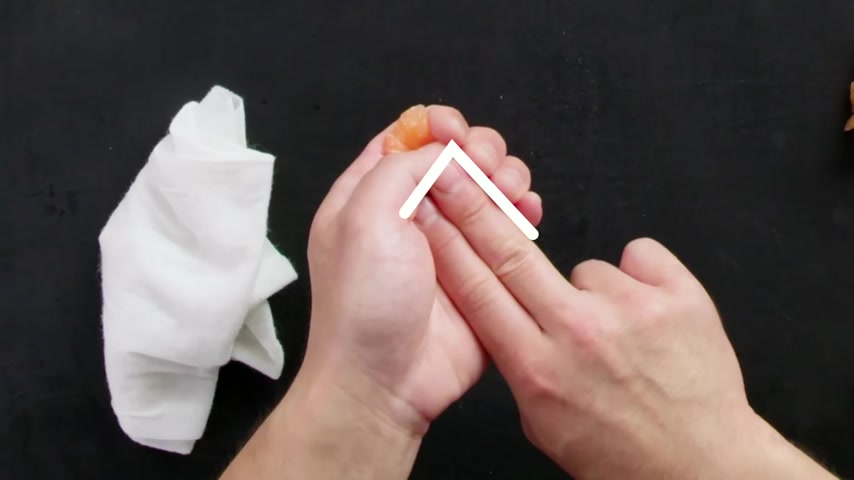
And then I'm going to repeat the process where the thumb is here , the fingers are here and I'm going to be gently pressing .
So really just trying to create this kind of rectangular shape in my hand .
And so once we create the rectangle here , then we want to turn this fish over and now it's really about bringing the fish and the rice together as one .
And so we're gently pressing here and as we press here , the rice has a tendency to come up .
And so we're just gently bringing that tip down and then we're going to repeat the process on the other side .
And then at the end , we call , this is very important where we're actually just gently going to grab the fish and the rice .
The last molding technique that we'll be doing is tai generally , this technique is used for fish or shellfish that's very smooth or slippery .
So we start off the same way here .
The major difference here is now we're going to flip this way and then reposition here .
And the reason why is for fish that are very smooth and slippery , sometimes turning it this way the rice and that whatever that Netta is will fall off .

And so in order to avoid that from happening , replacing it here and then repositioning in your hands .
It's just ta but finish the same way before serving to the guests .
I like to brush a little bit of soy sauce on the top and there you have it .
Tashi directly translates to box sushi .
This is also sometimes known as Oshizu which means to press pressed sushi .
This was first originated in Osaka , Japan Hakko is an homage to the style of sushi that existed before Omai sushi .
Previously , they used to take salted rice , put fish inside of the salted rice and press it firmly in a box to increase the fermentation rate .
So what we have here is something that's called shiba .
This one in particular is made out of a cypress wood .
We do want to soak this in water for a little bit just so that the surface is not as sticky .
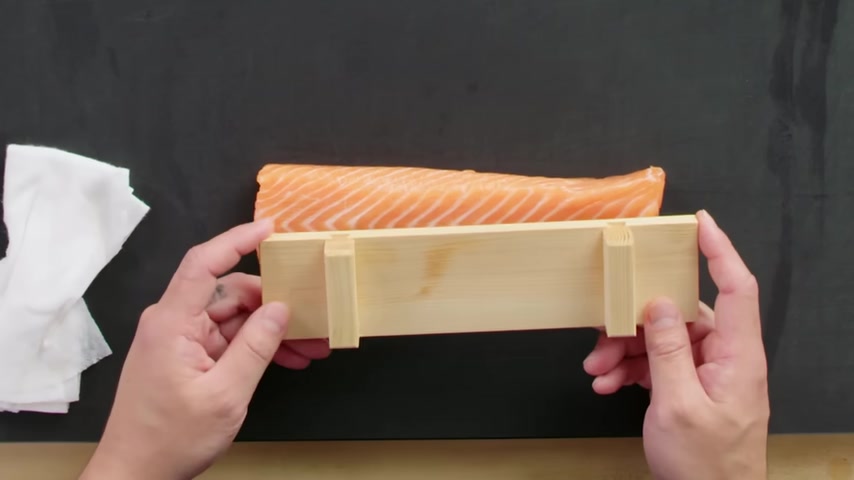
I've also used a piece of salsa here , bamboo leaf in order to line the bottom of it so that we can prevent some more sticking as well .
The first thing we're going to do is to prepare the fish .
I'm using the cover of the oshi baco to measure the size of the fish .
Obviously , if it's larger than this , feel free to off any of the ends .
And conversely , if it is too small , you can go ahead and use multiple pieces to fill the top of the box .
So I'm trying to get a very even place here .
And so cutting off the top , that's a little bit rounded and then we'll just be taking this slice and putting it on to essentially the bottom of the box .
And so you can see here that the width is not exactly filling .
And so again , we can go ahead and use other pieces and just to fill the empty spaces , any piece that ends up an off cut , we will utilize these in our other rules .
And so for the rice here , I will be adding some sesame seeds and mixing that in .
Well , I will going to be adding a layer of the tak one here .
This is diced radish , the pickled radish and on top of that , I'll be adding this rice .
This is a great place to be creative .

You can add any kind of ingredients , any other vegetables that you want .
So the next layer here , I'll be adding a little bit of color , so I'll be adding some leaves .
So Shiso is a type of herb flavor is closely related to mint and it does have a very herbaceous quality just like cilantro .
Now I'm going to repeat the same layer that we did before which is the and then finish it with the rice .
And really what we're looking for is when it's loosely packed , it should come up to almost the top .
I just want to make sure that the top of this has a slight moisture so that the rice doesn't stick .
And so the next step here is to put the top on and we're going to give this a very firm and even press , you can put , you know , go to monitor your weight on this .
And so you can see that it has gone down significantly .
And so the next step here is to slice it .
And conveniently , this design of this box comes with slits .
And so we'll just be following those slits and again , using a moist towel to wet the knife .
And we'll just be going down each layer and cutting this all the way through to the bottom .
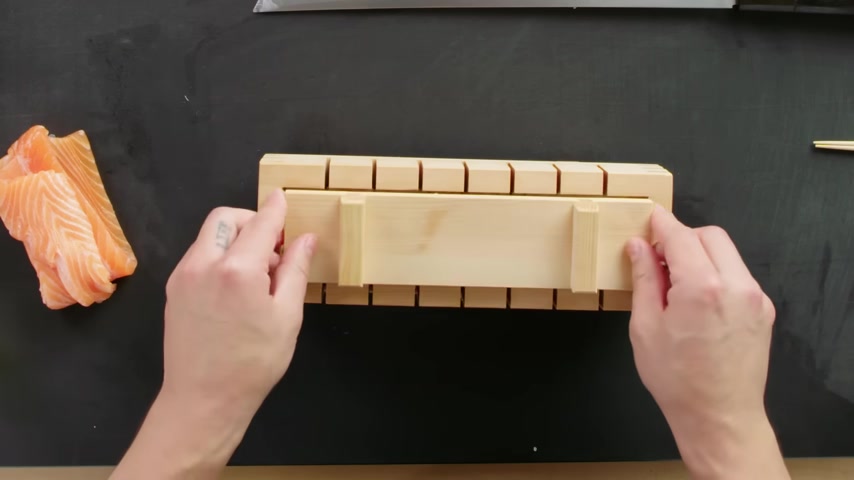
So the next step is to push the Hakko out of the box .
So we'll just be putting the cover gently back on just so that we can get a little bit of leverage to push this off .
Take this flip the whole thing .
And so since we put the uh sasa leaf here , the bamboo leaf , the top should come off nice and easily .
And we can go ahead and discard the sasa .
I'm gonna top this off with Katsu bushi , which is a smoked dried and fermented bonito fish which has then been shaved very thinly , just run along the top uh center .
This is the , this is another type of dried seaweed .
This is also another flavor and also nice color green color on the top .
So here we have it uh salmon Koshi .
It's been a long time since I had .
How close is you ?
Very good hoo means thin .
So it translates to thin rule .
This rule usually only has one filling the piece of salmon I have here is the edge piece from one of the saku that we made earlier .
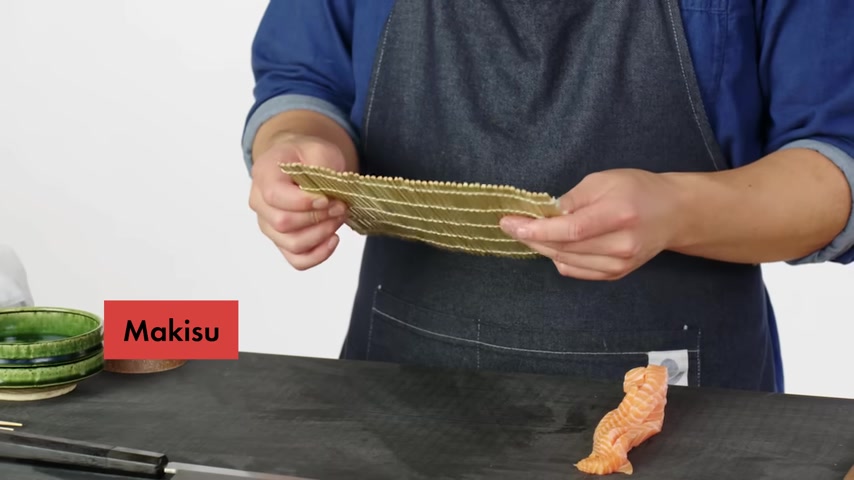
And so from here , all we're just going to look to do is to create a strip just what would fit generally in a roll .
This is called a maki .
So this is made out of bamboo and it's tied together with strings .
Essentially , this is designed to aid in the rolling process nori .
So this is a type of seaweed , there is a shiny side and a rough side .
And so for this particular roll , we want to make sure that the shiny side is on the outside , which is a little bit more presentable .
We're going to lay the nori right in the center of our maki soup and we're going to put the rice on the no and leave a few areas here with no rice at all .
One thing to help in the rolling process , I'm making a little bit of a ledge here on the edge .
I do like to put a little wasabi inside the rolls .
And so we take wasabi and gently glide it across in the center of the rice here .
And then we want to place the protein against the ledge that we made here that will help the protein not to slide around as we're rolling .
We want to bring the nori all the way down to the bottom edge of the maki soup .
And then we're just going to bring it all the way over .
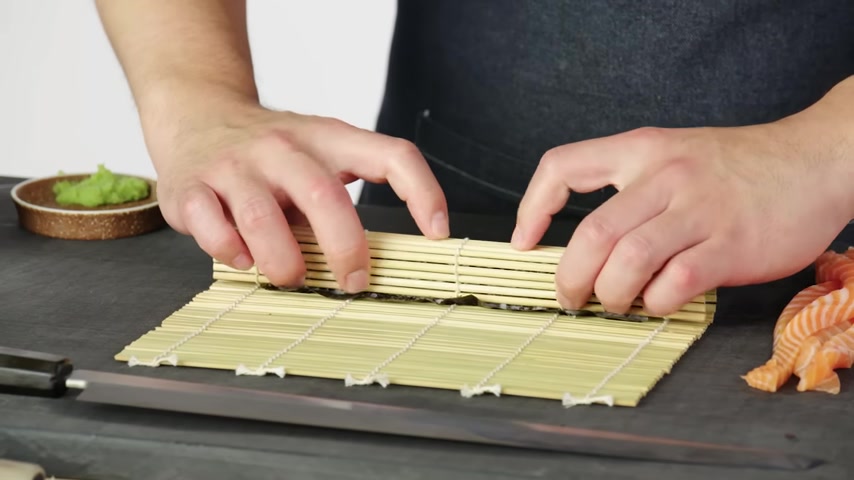
And we want to attach that bottom portion where there's no rice to that portion of the front where there's a ledge .
And essentially we're trying to create a square here .
And we're using our index finger on the top to form the last three sides of the square .
And you'll see here on the edge here that there is a little bit of a flap left over .
And all we're going to do is just roll that square over to cover that flap .
Once we flip it over the edge , we're going to reshape it to a square .
So first we're going to cut this into half and then we're going to combine the two pieces , cut the halves into thirds .
It's important to keep your knife with a little bit of moisture .
It'll help your knife glide through the rice .
So between each cut , I like to wipe off any of the excess of rice that's sticking and then move on to the next piece .
So here we have Tamaki directly translates to hand roll .
We will be doing three different types of Tamaki here .
Three different styles .
One will be a cylindrical shape .
One will be a cone shaped and one is more of like a open shaped taco .
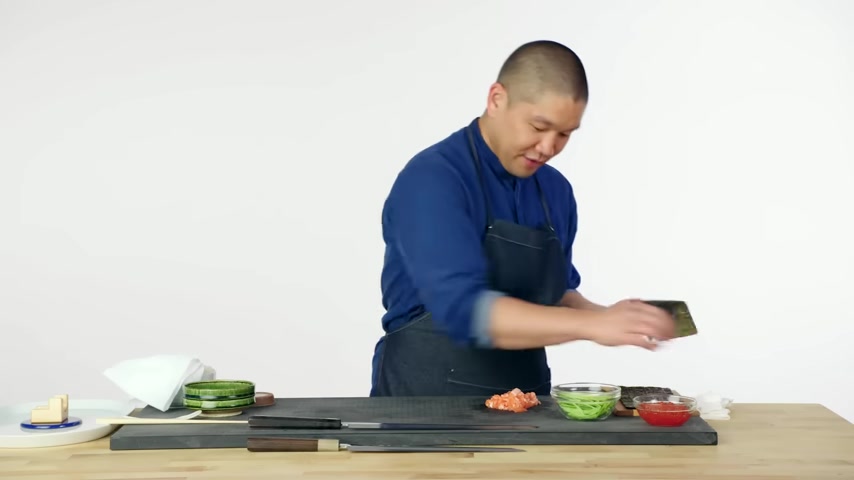
So first , I'd like to start with the cylindrical hand roll .
So again , the nori here we're going to be working lengthwise left and right .
Would you want to just grab a small amount of rice here just to cover the first section ?
And here we're going to add a little bit of wasabi here too .
And so for this cylindrical type , I'm going to be using the strips here and just putting in as much of the ingredients as I want .
Then from here , I will be just rolling this as like a cigar and that is your cylindrical style Tamaki .
And so the next one I like to show is the cone shaped .
In order to create the cone shape , we'll be putting the rice kind of at a diagonal and again , placing the wasabi here .
So I'm going to use the cubed salmon here .
So it's easier to eat .
And then we're just gonna take this corner here and bring it to the other side of the nori .
And from there , we're just going to roll this and wrap this up and this is your cone shaped Tamaki .
The last Tamaki I'd like to make for you is the taco shaped .
This is the Tamaki that we feature at NAMI Nori .
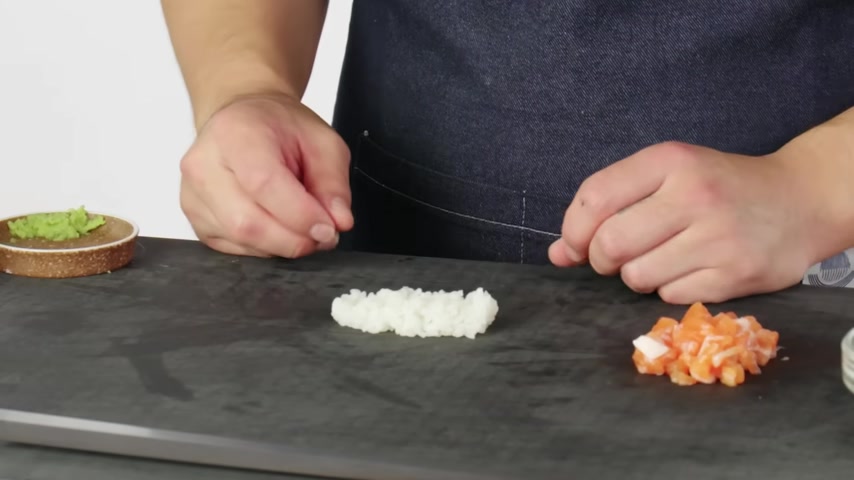
We're just going to create a little bit of an oval shaped piece of rice here and we're going to take wasabi and place it on top .
And for this one , we're gonna do a salmon I and cucumber .
So I'm gonna start with the cube cucumber , Julian , then gonna place the cubed salmon on top .
And on top of that , I'm gonna just gonna put a little bit of the , the salmon roe .
So we'll take this place it right into the center of the and we're gonna wrap it up like this and this is the U shaped tiki .
In other words , maybe a sushi taco , the salmon roll really adds some salinity and umami to this .
Tamaki is a Japanese word to scatter .
And originally this dish was created in order to utilize some of the off cuts .
In Japanese .
We have a saying called mona and really translates to what a waste this philosophy is to utilize everything that we can .

So the salmon I have here is off cut from when we were producing the koz sushi .
And so for this particular chira I'll be making today , I'm going to turn all these into cubes .
So just making batons first and then cutting it the lengthwise .
In order to make cubes to start the dish , we will create a base of sushi rice .
So how much rice you start with is a , a personal preference , but it should be balanced with the amount of fish that you plan to put on top .
This is called Kin Tamao .
This is basically an egg omelet .
And so what's in the mix here is the eggs that are scrambled , seasoning of salt or soy sauce .
And we add a little bit of starch to make sure that there's no residual moisture left over .
So next , I like to put on the salmon .
So this chira might reminds you of poke bowl .
But the differences here are in a poke bowl .
The fish is marinated in a particular sauce while Chi Rashi is unm marinated fish scattered on top of sushi rice .
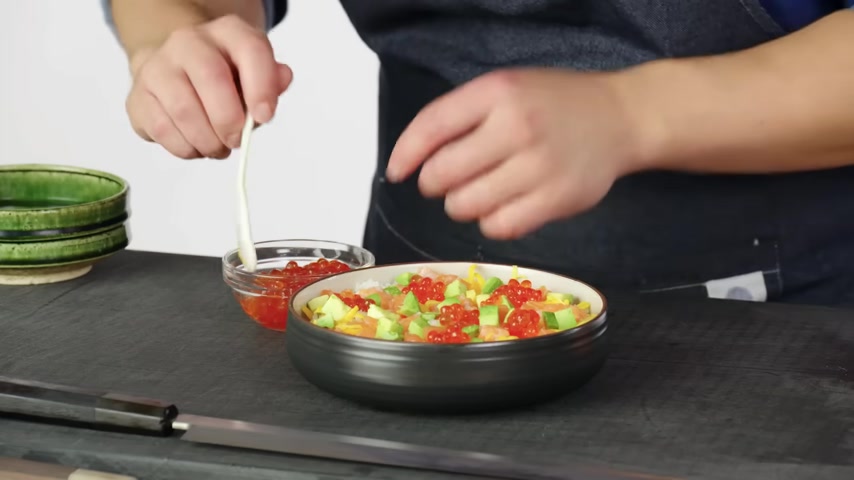
Next , we'll be adding the avocados and so next , I'll be adding the ira the salt cured salmon roe and I'll be putting this in small little dollops throughout the dish trying to keep things distant from each other .
Random but not random .
Next , I'll be adding the shi to .
This is a seven spice blend .
I like to put these into small pockets .
The most common ingredients for the seven spice blend is obviously chili peppers , sesame seeds .
A nori which is a type of seaweed and sometimes orange zest , yuzu zest and many other ingredients .
And so next , I'm going to finish with these cubed shiel leaves .
The last element I'd like to add to the dish is the square nori pieces nori to me adds like earthiness to all the dishes and also has great ocean flavor also has umami and some salinity to it as well .
And so here we have the salmon and I this is a great dish with different textures and different flavors and it really comes together all in the mouth .
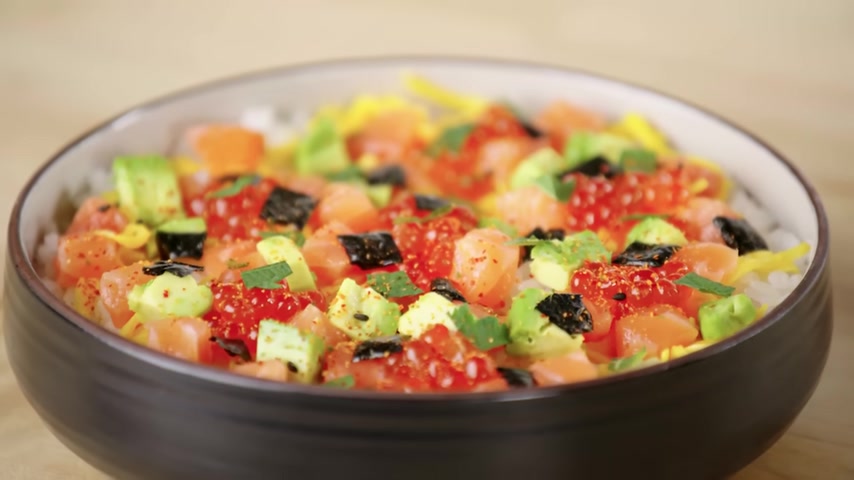
You have this salinity from the ika , the umami and the salmon is luscious and soft , really complimenting with the avocados .
Normally , you might see this with seven different types of fish and other vegetables and other ingredients .
So really do not be afraid to get creative and have fun with it .
Fuki directly translates to fat roll fuki generally always has multiple ingredients .
A seaweed will be on the outside of this roll .
So we want to showcase the shiny side again and for the , we'll be flipping it so that the length is longer up and down , we'll be grabbing the amount of rice to make one layer on the nori .
And uh similar to the , we will be leaving gaps on the top and the bottom of the roll .
And so we just want to pull all this rice down .
And important here is to make sure that the edges are filled to look something like that .
We'll be putting a little bit of wasabi into the center of a roll again and then we'll be starting with the scho leaf and then working with our proteins .
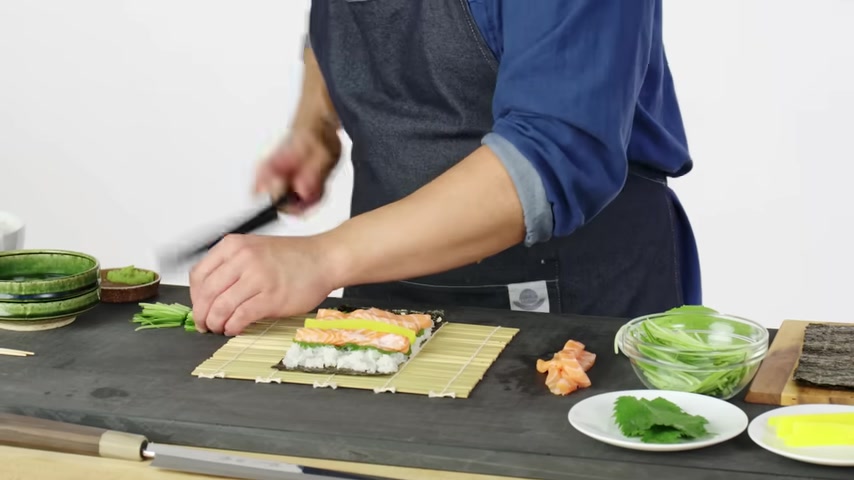
I'm going to put some in the front and putting some in the back here generally for it is so large that it's hard to eat in one bite .
And so if I'm using one main protein ingredient , I like to split it up between so that you can have the protein in every bite and then the rest of the vegetables , I'll be including it to the center here .
So I have Tawan and then we have our cucumbers just so the edge remains nice and clean .
I'm going to cut this in half first and using the cut edge , putting that on the outside and I'll fill the center with some more loose Julian .
And the last ingredient I'll be adding here is the avocado tomake generally has multiple ingredients .
This is one of the most common sushi that is made at home sometimes during the holidays or even some special beto that kids might take to school .
And now we're going to roll this all up .
And again , we want to make sure that the bottom edge here is all the way to the bottom of the maki .
So , and using our hands , we want to kind of uh make sure that the ingredients don't fly out forward just gently .
We're gonna bring the edge of the no to the front of the rice .
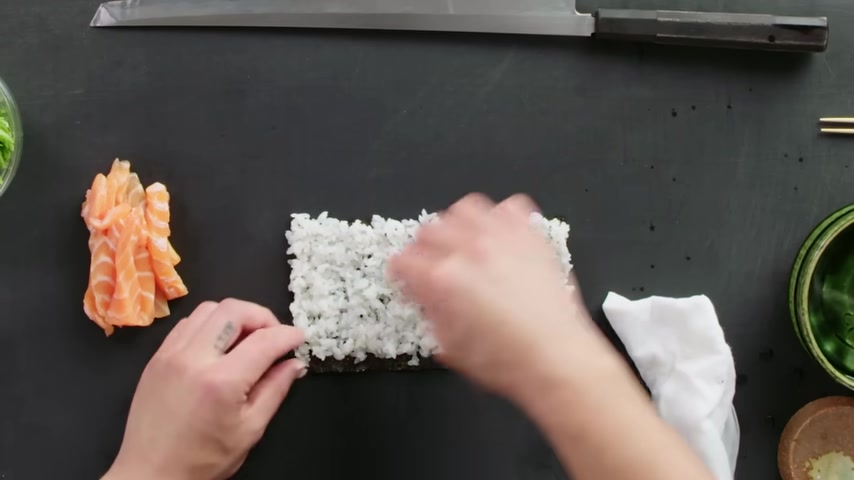
And it's important here that once we get here that there is a little bit of residual rice left over , that's really gonna help us to seal the seaweed and close the roll .
And so once we get here , we want to gently roll past so that now it is closed , use the maki .
So now to reshape and make sure that it's nice and cylindrical and just tucking in the edges .
So again , we want to make sure our blade has a little bit of moisture and we're gonna cut this roll into five pieces .
So starting with the first one here and then after you've cut the first one , if you want , you can cut this into half and then cut these into halves as well .
And so this is our salmon Kiki being so large , it is very difficult to eat in one bite but not impossible .
Ki means inside out .
So now instead of the seaweed being on the outside , the rice will be on the outside .
The direction in which we use the nori is a little bit less important , whichever side you grab it first , I think is fine .
Again , we'll be grabbing the amount of rice to cover the nori with one layer of rice .
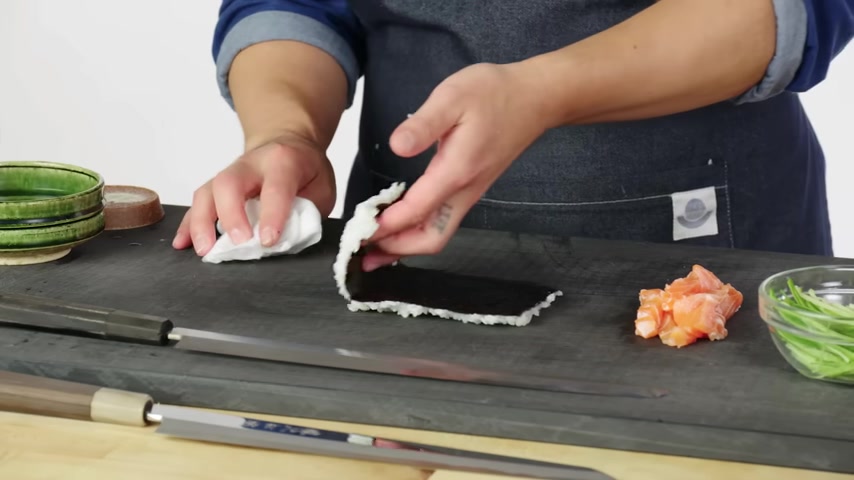
So we'll start in the center here and pull towards the ends of making sure all the edges are covered except for the very bottom edge .
And so now once we've covered the nori with rice , we're going to flip this over and now we're going to fill it with our .
So first we're going to start with our protein for this variety , we'll be filling it with spicy salmon .
We have a little spicy mayo prepared .
So some spicy salmon is chopped up and mixed with the sauce .
I like to have my ingredients as whole as possible .
And so I prefer to make it this way .
And so once all all of our ingredients are inside , now we're going to roll and so just going to slightly dampen our hands here and we're going to pull from the bottom of the sheet .
Once we get here , we just want to tuck it in as tightly as we can .
You don't need to over tighten and then all we need to do is roll it over the edge .
So now this maki sow is now covered with plastic wrap , this will help the rice not stick to the maki sow .
And now we're going to just use this to reshape and make it cylindrical .
And so we're just going to cover the top of it and again , gently squeeze and we're just going to make sure that the edges are nice and tucked in top this off with shi toga .
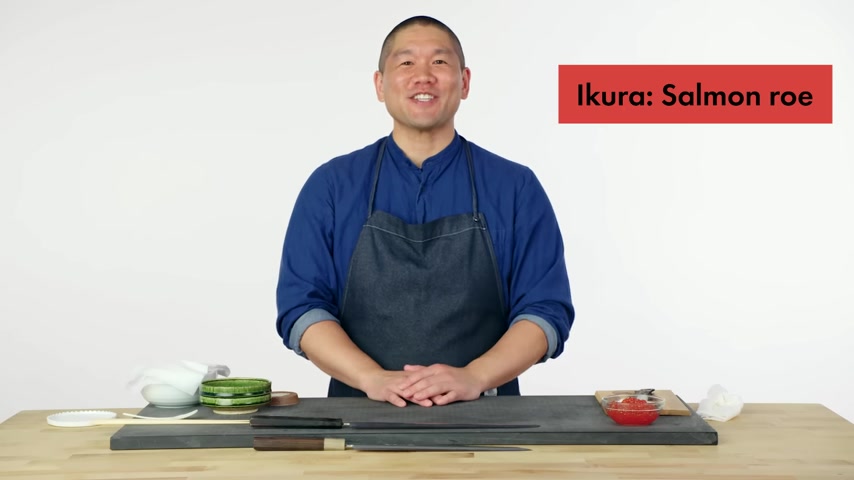
And so generally for this maki , we do cut this into eight pieces , wiping the knife down to make sure that it's clean and there's a little bit of moisture .
And so for this , just cut this in half and then bring it together , cut these in half until we have eight pieces .
So half here , half again and half , one more time .
So the plate , I have a plate here lined with a piece of salsa leaf , which is a bamboo leaf and there you have with spicy salmon .
Yura is salt cured salmon , Roe and guan meaning battleship referring to the shape of the sushi .
Again , we're going to be using the teu to moisten our hands .
So we're going to grab a little bit more rice than we did for the Nigiri sushi .
And we will be using the same techniques to form the rice .
And we have the thumb here on the top and our other fingers here forming the l shape here and doing this flip and again , l shaped on the other side and then reverting back and finalizing the rectangle .
So here , we're gonna add a little bit of wasabi here .
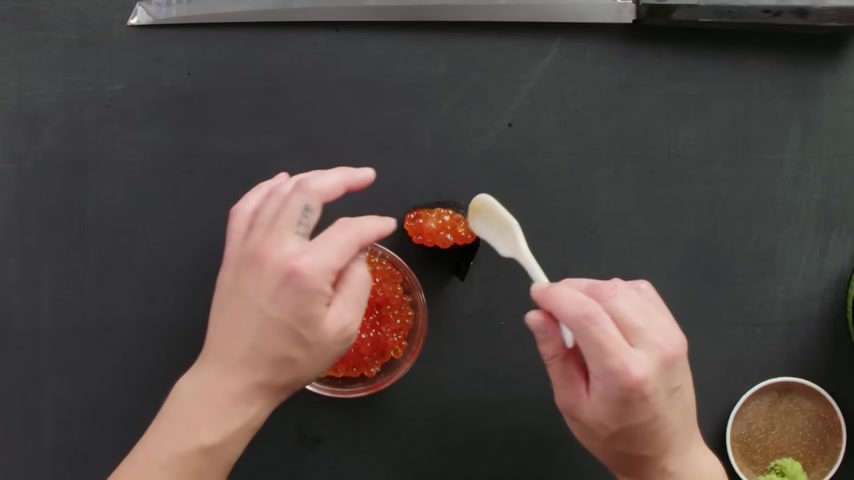
And so I have a few strips of nori here for this mucky .
And so for here , we're just gonna wrap this around the rice and we're just gonna fill this with our ingredient .
This is I'm just looking at the shape of the , and I just want to have a nice curvature over the top .
The straight from the salmon has very little flavor .
And in order to kind of elevate the natural flavor , there's two ways in which it is processed .
Uh one is to salt , cure it and the other is to marinate it in soy sauce .
So the one we have here is a salt cured salmon roll .
Sashimi is just sliced raw fish .
Again , the distinction of sushi has to involve the vinegar rice and here there's no vinegar rice .
So this is not considered sushi .
It has become a staple in every sushi restaurant to offer sashimi .
And so that is why we wanted to showcase this today .
I like to showcase two types of cutting techniques .
One is so Zuri and the other .
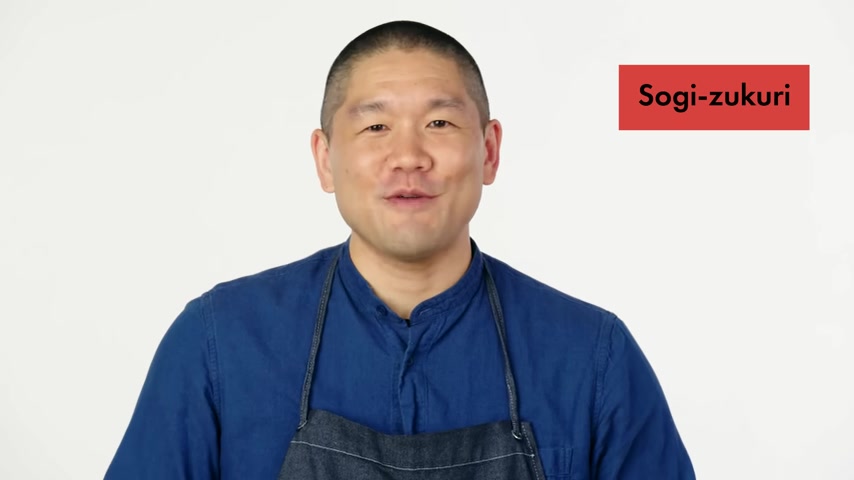
Hi Zui Sozu is the same technique that we showcased in our needy demonstration .
Again , we like to cut against the sine line as we did before .
And we want to start at the heel of our knife so that we have most as much surface area to cut as possible and follow through all the way down .
And so the difference here is that for when we cut for the , we made a which was turning the corner , but in this case , we're just going to go all the way straight down .
And now to demonstrate the Kizu , this technique is predominantly used on fish that have a little bit looser meat that easily breaks apart from the .
And so we're starting all the way at the heel of the knife and we're going to slightly angle the knife away from our hands .
So there's two reasons for that .
And one of them is to make sure that we're not cutting our fingers .
The other reason is to create a little live edge here .
And I'll show you after I make the slices here .
And so the idea here is to go into one stroke , cut and then place the fish how it's going to be plated .
And so that there's very minimal movement of the fish .
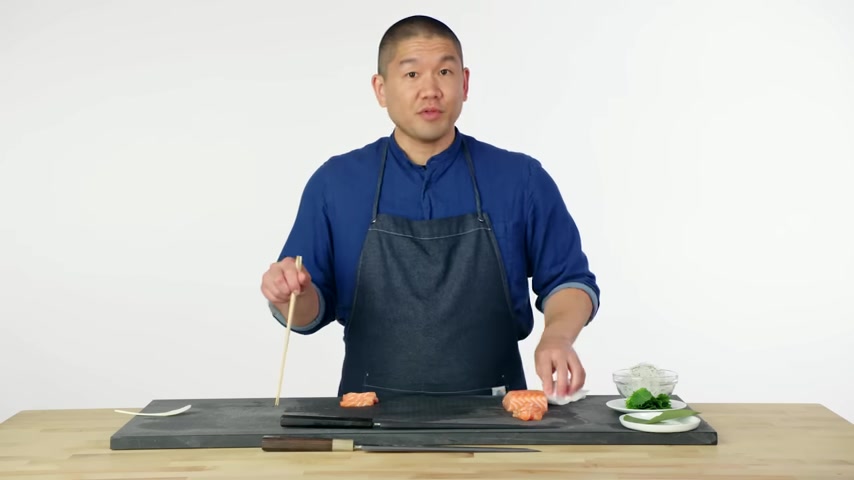
And when I a live edge by creating that angle , this edge is now protruding versus looking like one block .
And so that slight angle is going to create this separation .
And so next , I'll be plating the sashimi .
And in doing so , we like to use something called Auma .
This is basically Dion radish and Shiso that's been very thinly cut .
So we just go center plate here , a piece of and this is salmon sashimi making sushi is an art that takes years to perfect .
Now that you've got a glimpse into the different varieties of sushi .
You can get started at home today , get yourself a rice cooker and start practicing .
And maybe in 10 years , you could be making this video .
Are you looking for a way to reach a wider audience and get more views on your videos?
Our innovative video to text transcribing service can help you do just that.
We provide accurate transcriptions of your videos along with visual content that will help you attract new viewers and keep them engaged. Plus, our data analytics and ad campaign tools can help you monetize your content and maximize your revenue.
Let's partner up and take your video content to the next level!
Contact us today to learn more.